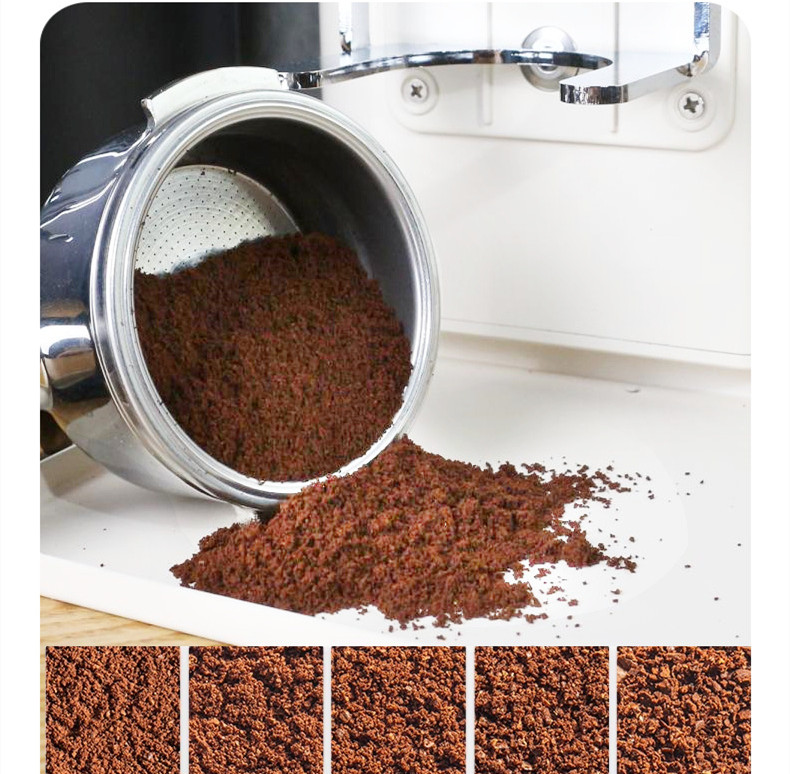Daily cleaning steps and frequency guide for coffee grinders
First, cleaning steps: Operate in separate areas to avoid residue
The cleaning of a coffee grinder requires different methods based on the characteristics of areas such as the cutter head, bean bin, and passage. The following is the specific operation process:
1. Cleaning of the cutter head and grinding chamber (core area)
Steps
Power off and disassemble the cutter head: After ensuring that the grinding machine is completely powered off, disassemble the cutter head assembly as per the instructions (for some models, special tools are required).
Brush to remove residual coffee powder: Use a brush (preferably made of nylon or bristle) to clear the coffee powder residue in the gaps of the cutter head and the inner wall of the grinding chamber, and avoid scratching the cutter head with metal tools.
Air-blowing or vacuum cleaner assistance: For hard-to-reach corners, use an air-blowing or small vacuum cleaner (with a fine tube head) for further cleaning.
Damp cloth wipe (optional) : If there are stubborn oil stains on the cutter head, gently wipe it with a slightly damp soft cloth (be careful to prevent rust), and then dry it thoroughly.
Notes
Avoid directly rinsing the cutter head with water to prevent water from entering the motor or the cutter head from rusting.
Regularly inspect the wear of the cutter head and replace it if necessary (such as when there are notches in the conical cutter or the surface of the flat cutter is uneven).
2. Cleaning of the bean bin and the powder receiving cup (the area in contact with coffee beans)
Steps
Bean bin cleaning: After emptying the bean bin, wipe the inner walls with a dry cloth to remove any remaining coffee oil. If the bean bin is detachable, it can be cleaned with warm water and neutral detergent, but it must be thoroughly dried before reinstallation.
Cleaning of the coffee powder collection cup: Rinse the coffee powder collection cup directly with clean water. If necessary, use a soft-bristled brush to clean the coffee powder from the rim of the cup or the magnetic attraction area.
Sealing ring inspection: If there is a sealing ring in the bean bin or the powder receiving cup, it is necessary to regularly check whether it is aged or deformed, and replace it if necessary.
Notes
Avoid using cleaning agents containing alcohol or strong acids and alkalis to prevent corrosion of the material.
Poor sealing of the bean bin may cause the coffee beans to get damp. It is necessary to clean it in time and keep it dry.
3. Clean the channel and the powder outlet (to prevent blockage)
Steps
Channel cleaning: Use a fine-bristled brush or a pipe cleaning stick (such as a special cleaning brush for coffee machines) to clean the coffee powder outlet channel to prevent the coffee powder from clumping.
Powder outlet cleaning: Wipe the outside of the powder outlet with a damp cloth. If there is any residue inside, you can gently unclog it with a toothpick or a fine needle (wrapped in a soft cloth).
Anti-static treatment: After cleaning, a small amount of water mist can be sprayed on the channel with an RDT sprayer (or a household spray bottle) to reduce static electricity adsorption.
Notes
Avoid poking the powder outlet forcefully to prevent damage to the internal structure.
Regularly check whether the coffee powder outlet is aligned with the powder receiving cup to prevent coffee powder from splashing during grinding.
Second, cleaning frequency: Adjust according to the usage scenario
The cleaning frequency should be comprehensively judged in combination with factors such as usage frequency, type of coffee beans, and environmental humidity. The following is a recommended plan:
1. Daily cleaning (after each use
Applicable scenarios: High-frequency use (such as multiple grinding times a day) or deep-roasted bean grinding.
Operation content
Clean the residual powder from the cutter head and grinding chamber (brush + air blowing).
Wipe the exterior of the bean bin and the powder collection cup.
Check if there is any residue at the powder outlet.
The reason is that dark-roasted beans have a high oil content, which makes them prone to residue and clogging the grinding chamber.
2. Deep cleaning (weekly/monthly)
Applicable scenarios: Low-frequency use (such as 1-2 times a week) or light roasting and grinding of beans.
Operation content
Disassemble the cutter head and thoroughly clean it (wipe with a damp cloth and let it dry).
Clean the bean bin and the powder collection cup (warm water + neutral detergent).
Clean the powder discharge channel and powder outlet.
The reason is that the powder of lightly roasted beans is finer after grinding and is prone to accumulate in the channels.
3. Seasonal Maintenance (every quarter
Applicable scenarios: Damp or dry environments.
Operation content
Check the wear of the cutter head and calibrate the grinding degree if necessary.
Clean the motor vent (to prevent dust accumulation from causing overheating).
Carry out moisture-proof treatment on the bean storage bin and the powder collection cup (such as placing desiccants).
The reason is that a humid environment is prone to causing coffee grounds to clump, while a dry environment is likely to generate static electricity.
Third, recommendations for cleaning tools and a guide to avoiding pitfalls
Essential tools
Nylon/pig bristle brush (avoid metal brushes damaging the cutter head).
A fine-tube vacuum cleaner or air blower (for cleaning residual powder in crevices).
A slightly damp soft cloth (for wiping oil stains, it must be thoroughly dried).
Pitfall Avoidance Guide
Avoid washing the cutter head with water: Unless explicitly permitted in the instruction manual, the cutter head should not be soaked or rinsed.
Use cleaning agents with caution: Cleaning agents containing alcohol or strong acids and alkalis can corrode the material, causing the cutter head to rust or the sealing ring to age.
Regular inspection of wear: Wear of the cutter head can lead to uneven grinding and should be replaced in a timely manner (for example, it is recommended to replace the conical cutter every 1-2 years).
Fourth, Summary
Core logic of cleaning
High-frequency area (cutter head, powder outlet) : Clean after each use to prevent residue and caking.
Contact areas with coffee beans (bean bin, powder receiving cup) : Clean weekly to prevent oil accumulation.
Seasonal maintenance: Inspect the cutter head and motor every quarter to adapt to environmental changes.
Operation mnemonic
“Clean the brush on the knife disc frequently and wash the cups in the bean bin regularly.”
The powder outlet of the channel is protected from clogging, and seasonal maintenance ensures performance.”
By scientifically planning the cleaning steps and frequency, the service life of the grinding machine can be effectively prolonged, the grinding quality can be maintained stably, and flavor deterioration or equipment failure caused by residues can be avoided.


